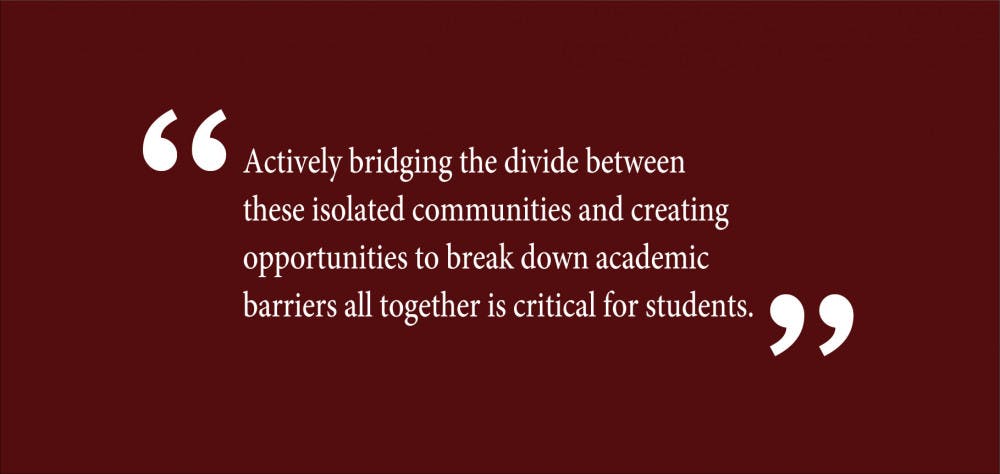Universities function as conduits for insular communities — your cohort, the other people in your concentration, your housemates and others. The further you commit to one course of study and the deeper you dive into a particular field, the more insulated these communities can become. While heavy specialization is critical for furthering academic research, so too is interdisciplinary work and collaboration. Actively bridging the divide between these isolated communities and creating opportunities to break down academic barriers all together is critical for students. Breaking down barriers ensures students’ later success and opens new opportunities for discovery in academia.
Bridging the gap between art and science fits into a larger trend of STEAM — Science, Technology, Engineering, Art and Math — education that returns art to its place among the STEM fields. This division between studies of science and studies of art or the humanities has a lengthy history. Since C.P. Snow’s influential “Two Cultures” lecture in 1959, which describes the sciences and the humanities as two different cultures, educators have debated the nature of the relationship between art and science. Thus, our education system has long been divided.
Recent focus on STEM has accentuated this divide. Many have called to increase student engagement in STEM fields, including the Obama White House. More locally, the Rhode Island Commerce Corporation offers a fellowship to defray student loan repayments for those who choose to major in STEM fields and work in Rhode Island. Because high-schoolers have little choice in their curriculum, college students face the brunt of this pressure to pursue STEM. Faced with the choice of selecting brand new classes and disciplines, first years are told to concentrate in STEM fields, at the expense of the arts, in order to make money.
This emphasis on STEM wrongfully devalues humanities and further inhibits any intersection between the two silos. Humanities courses help students become critical thinkers, better writers and engage their creativity. More than that, the university experience shouldn’t be about making the maximum amount of money immediately after matriculation. While preparing students for jobs is important, limiting our educational experiences through the artificial art and science division doesn’t prepare students for the workplace. In fact, many companies now actively look to hire people with backgrounds in both the humanities and STEM fields.
Futhermore, breaking down this divide allows for innovative problem-solving techniques. For example, playing with new ways of communicating research advancements through design is especially important in the digital age and can contribute to further funding opportunities.
Providing a platform for interdisciplinary work and a method for showcasing it to the greater community is critical for furthering an emphasis on STEAM. To that end, Brown is well-positioned to offer students opportunities for STEAM education. Nearby RISD led the push for including the arts (as well as the humanities and the social sciences) in STEM education. Brown students collaborating with RISD students through projects and clubs have the opportunity to engage with STEAM at its origin, benefiting from years of experience and additional resources available to them through RISD.
But there are also many ways to engage with the intersection of the arts and sciences at the University, itself. Discover, a student led STEAM exhibition, allows University students to collaborate with RISD to generate art exhibits that interrogate the relationship between the STEAM fields . The University’s Catalyst journal features science-inspired writing and art. More straightforward involvement can be found with groups like Brown STEAM, where students can play with the intersection of art and science on campus and with the greater Providence community.
Within individual classes, too, professors can place an emphasis on STEAM. Professors can engage with this even in classes that initially appear to belong wholly to one category or the other. Incorporating authors from diverse fields and preparing activities that go beyond the standard essay or problem set can push students outside of their comfort zones.
Brown offers many ways to engage in STEAM education, through its clubs, organizations and the Open Curriculum, but we can do more to encourage interdisciplinary work. Centering collaboration between disparate fields within classes and increasing participation at campus and community STEAM events can help further the important cause of tearing down the artificial divide between academic fields.
E.L. Meszaros GS can be reached at e.l.meszaros@brown.edu. Please send responses to this opinion to letters@browndailyherald.com and op-eds to opinions@browndailyherald.com.



